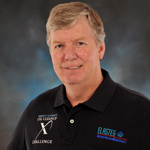
 By Don Johnson
By Don Johnson
Elastec/American Marine Team Leader, Wendy Schmidt Oil Cleanup X CHALLENGE
I remember the audible gasp from most everyone at the awards ceremony last year. Robert Weiss, President of the X PRIZE Foundation, had just announced that Team Elastec/American Marine had won the Wendy Schmidt Oil Cleanup X CHALLENGE. Our skimmer system had delivered an astonishing oil recovery rate of 4,670 gallons per minute at a nearly 90 percent efficiency ratio of oil to water. In just six months, the X PRIZE Foundation had become the catalyst to advance the efficiencies of oil spill recovery more than in the previous twenty years.
Why had the breakthrough taken so long? It wasn't because we could not do it. We, as an industry, simply chose not to. Several advancements had been made over the years. But the bottom line is that if we had invested the money and developed a larger system, would customers have been willing to spend the money to inventory equipment and wait for an accident to happen? The answer was no, so we chose not to attempt it.
The 2010 Deepwater Horizon incident prompted the X PRIZE Foundation and Wendy Schmidt to invite not just the oil recovery industry, but anyone with imagination and drive to take on a daunting challenge. The goal was to produce a system capable of recovering oil from the surface of water at a minimum rate of 2,500 gallons per minute, with an oil to water efficiency of at least 70 percent, while being towed at 1 to 4 knots -- and to do this in both calm and wave conditions.
Over 350 teams from around the world took up the challenge. Ten finalists from four nations tested their technologies in actual oil on water conditions at the National Oil Spill Response Research and Renewable Energy Test Facility (Ohmsett) test tank in New Jersey. The X PRIZE Foundation provided the right mixture of competition and monetary incentive.
The secrecy surrounding the competitors' entries lent additional incentive. When we at Elastec/American Marine first tested our grooved disc (the heart of our system), we knew we had something extraordinary. The question was, what were we comfortable with? The minimum requirement was 2,500 gpm, so that was not a "goal." We assumed that everyone else was aiming at 3,000, but what if those teams that aspired to 3,500, or even 4,000? Prior to the Wendy Schmidt Oil Cleanup X CHALLENGE, if you were to bring up those figures in relation to skimming possibilities, you would have been dismissed as a dreamer. But the dream of winning $1 million and the fame that comes with winning one of the X PRIZE Foundation's competitions now seemed within reach.
Hearing our name announced as winner of the Wendy Schmidt Oil Cleanup X CHALLENGE gave us reason to celebrate all the hard work. However, it turned out to be just the beginning of what we believe is a new direction in the field of mechanical oil spill collection. To conform to all of the requirements of the competition, we had to develop a forward moving skimmer collection system. That had not yet been successfully accomplished.
Conventional oil spill clean-up methods prior to the Wendy Schmidt Oil Cleanup X CHALLENGE involved containment, then collection. Some systems could move forward and collect oil, but then the whole process ground to a halt while a skimmer was either put into the collected oil or activated so that the collected oil could be pumped into a holding tank. Attempts had been made to couple skimmers and collection booms so one could keep skimming, but you still had two different systems trying to act as one. They just did not work efficiently.
The elusive goal was to maximize the encounter rate. The Wendy Schmidt Oil Cleanup X CHALLENGE forced us to create a system able to encounter large quantities of oil spread over the surface. It doesn't matter if you have a system "capable" of pumping 10,000 gallons a minute. If you are not encountering the oil, you are not picking it up. Our system did just that, on a grand scale.
Now the challenge is to prove that this technology can be scaled to meet the many different environmental, transportation and deployment scenarios that occur in real-world spill situations.
The system's first generation targeted the footprint needed to fit in a small cargo plane for fast response. We developed a towable boom and skimmer system, the X150, signifying cubic meters per hour. We returned to Ohmsett to test this system, and results were good -- so good that an X250 is planned. The concept of a skimmer that can handle a large flow of water while also skimming oil opens up several possibilities: large systems for ocean spills, for instance, or systems that could be positioned across rivers, downstream from a spill, establishing a "fire line" for the capture of the oil.
The Wendy Schmidt Oil Cleanup X CHALLENGE brought together teams that have been in the industry for some time -- and some with fresh new ideas. We have been in communication with some of those teams and have shared technologies and ideas to enhance each other's systems. Competitive collaboration: another plus for the competition.
It is hard to describe all of the benefits we have experienced because of our association with the Wendy Schmidt Oil Cleanup X CHALLENGE, primarily because that book has not been completed. Our system has already been honored by National Geographic and the Washington Post as among the best innovations of 2011. We also received the Regional Clean Sea Organization's "Excellence in Environmental Technology" award earlier this year in Dubai. We feel the technology that was developed as a result of the competition has definitely raised the bar and will continue to set new standards for the performance of the equipment used in the oil spill clean-up industry.
The X PRIZE Foundation and Wendy Schmidt set out "to inspire a new generation of surface oil spill cleanup technologies." With the help of all of the teams involved in the competition, they have accomplished just that. We at Elastec/American Marine thank the X PRIZE Foundation, Dr. Diamandis and Wendy Schmidt for their efforts to help keep our world clean. I hope that others will appreciate the foundation's contributions and will support it in each of its future challenges. I know that we will.
Visit X PRIZE at xprize.org, follow us on Facebook, Twitter and Google+, and get our Newsletter to stay informed.